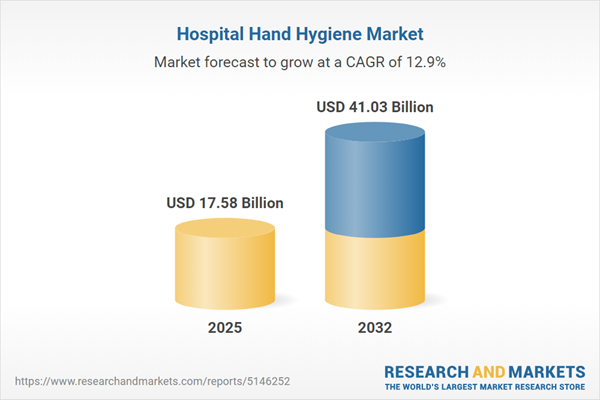Speak directly to the analyst to clarify any post sales queries you may have.
The hospital hand hygiene market is evolving quickly as healthcare institutions respond to regulatory shifts, changes in procurement strategies, and ongoing advancement in infection control technologies. For senior leaders, integrating effective hand hygiene solutions is an operational necessity for minimizing infection risks and upholding compliance throughout increasingly complex care environments.
Market Snapshot: Hospital Hand Hygiene Market Size and Growth
The global hospital hand hygiene market is experiencing steady expansion, underpinned by rising compliance expectations and robust adoption of digital procurement tools. Healthcare providers are implementing integrated hygiene systems that facilitate adherence through real-time tracking and automated process monitoring. These advancements enable benchmarking of hygiene performance, help drive consistent practices across both single and multisite operations, and provide practical decision support for evaluating product options. As connected dispensers and analytics platforms become mainstream, measurable improvements in patient safety and operational continuity are emerging in care delivery.
Scope & Segmentation: Hospital Hand Hygiene Market
A thorough segmentation of the hospital hand hygiene market allows leaders to tailor infection prevention strategies and address distinct operational, regulatory, and sustainability requirements at both the local and regional levels. Evolving technology and policy frameworks further amplify opportunities for targeted improvements.
- Product Types: Alcohol-based options, including ethanol and isopropanol, and non-alcohol alternatives such as chlorhexidine and iodophor, enable flexible risk management across varied clinical protocols.
- Product Forms: Gels, foams, liquids, and wipes are available to accommodate healthcare personnel preferences and improve protocol adherence in diverse patient care settings.
- Packaging Types: Portable bottles, wall-mounted dispensers, tubs, and bulk packaging facilitate efficient deployment from general wards to intensive care units and specialized care environments.
- End Users: Custom solutions address the unique demands of hospitals, ICUs, emergency departments, surgical centers, clinics, and nursing homes, broadening infection prevention coverage.
- Applications: Routine cleansing, maintenance of surgical site hygiene, and post-procedure care support rigorous infection control at multiple workflow points within hospitals.
- Distribution Channels: Direct manufacturer sales, distribution partners, and pharmacy networks provide responsive sourcing and product access for healthcare organizations.
- Geographies: Coverage spans the Americas, Europe, Middle East, Africa, and Asia-Pacific. Each region presents specific challenges for compliance, procurement, and adoption, reflecting differences in regulatory environments and standards.
- Key Companies: Market innovation is driven by established players including GOJO Industries, Ecolab, Pudumjee Hygiene, the Leapfrog Group, AiRISTA, BioVigil, Kimberly-Clark, B. Braun, Essity, and Medline Industries, who shape competitive strategies and technology deployment.
Key Takeaways for Senior Decision-Makers
- Streamlined compliance frameworks provide a practical pathway for maintaining infection control during regulatory updates.
- Widespread adoption of contactless sanitizing and diverse product forms supports workflow integration, staff adoption, and reliable hygiene outcomes.
- Automated feedback and reminder functionality drives process reliability, continuous improvement, and overall organizational transparency in infection prevention.
- Focusing on sustainable procurement aligns with environmental responsibility and enhances confidence among key internal and external stakeholders.
- Analytics-driven training and operational optimization foster measurable progress, shaping a culture of performance and accountability.
- Segmented product portfolios and adaptable sourcing strategies provide supply chain resilience, essential during regulatory or market disruptions.
Tariff Impact: Strategic Supply Chain Shifts in 2025
Increasing tariffs on ethanol and surfactant ingredients in the United States are driving hospitals to reassess sourcing priorities and strengthen ties to domestic and regional suppliers. This shift is enhancing procurement security and responsiveness. Additionally, collaborative purchasing initiatives are emerging as an effective way to share risk, moderate pricing pressures, and reduce potential supply chain interruptions within the hospital hand hygiene sector.
Methodology & Data Sources
This hospital hand hygiene market report utilizes structured interviews with industry stakeholders, comprehensive reviews of recent literature, and ongoing surveillance of regulatory trends. All findings and strategies have been validated by subject matter experts to ensure their practical and actionable relevance for healthcare leaders.
Why This Report Matters for Hospital Leadership
- Delivers benchmarks for current infection prevention solutions and facilitates more rapid technology integration across diverse hospital scenarios.
- Supports executives in developing strategies for compliance, streamlined procurement, and alignment with sustainability targets as healthcare systems evolve.
- Supplies actionable recommendations to optimize process, technology, and resource allocation to strengthen outcomes organization-wide.
Conclusion
As regulatory, supply chain, and infection risks continue to evolve, this report equips senior hospital leaders with strategic insights for resilient, proactive infection prevention in dynamic clinical settings.
Additional Product Information:
- Purchase of this report includes 1 year online access with quarterly updates.
- This report can be updated on request. Please contact our Customer Experience team using the Ask a Question widget on our website.
Table of Contents
3. Executive Summary
4. Market Overview
7. Cumulative Impact of Artificial Intelligence 2025
Companies Mentioned
The companies profiled in this Hospital Hand Hygiene market report include:- GOJO Industries, Inc.
- Ecolab Inc.
- Pudumjee Hygiene
- The Leapfrog Group
- AiRISTA
- BioVigil Healthcare Systems, Inc
- Kimberly-Clark Corporation
- B. Braun SE
- Essity AB
- Medline Industries, Inc.
Table Information
| Report Attribute | Details |
|---|---|
| No. of Pages | 189 |
| Published | October 2025 |
| Forecast Period | 2025 - 2032 |
| Estimated Market Value ( USD | $ 17.58 Billion |
| Forecasted Market Value ( USD | $ 41.03 Billion |
| Compound Annual Growth Rate | 12.8% |
| Regions Covered | Global |
| No. of Companies Mentioned | 11 |









